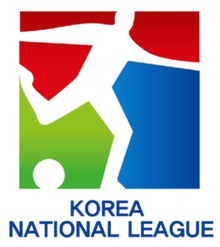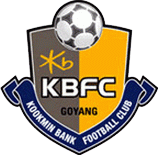Championship playoff
Summary
| Team 1 | Agg. | Team 2 | 1st leg | 2nd leg |
|---|---|---|---|---|
| Gangneung City | 1–4 | Goyang Kookmin Bank (C) | 1–2 | 0–2 |
Results
| Gangneung City | 1–2 | Goyang Kookmin Bank |
|---|---|---|
| Ha Sung-yong | Kim Dong-min |
Goyang Kookmin Bank won 4–1 on aggregate.
| Season | 2004 |
|---|---|
| Champions | Goyang Kookmin Bank (2nd title) |
| Matches played | 92 |
| Goals scored | 221 (2.4 per match) |
| Best Player | First stage: Kim Yoon-dong [1] Second stage: Kim Hae-gook [2] Playoff: Kim Dong-min [3] |
| Top goalscorer | Kim Jae-cheon (8 goals) [4] |
| Biggest home win | HMD 4–0 Gangneung (28 August 2004) |
| Biggest away win | Sangmu 1–5 HMD (30 May 2004) |
| Highest scoring | Hummel 3–3 Hallelujah (16 May 2004) HMD 4–2 Hummel (22 May 2004) Sangmu 1–5 HMD (30 May 2004) KHNP 3–3 Suwon (29 August 2004) |
| Longest winning run | 8 matches Hyundai Mipo Dockyard |
| Longest unbeaten run | 18 matches Hyundai Mipo Dockyard |
| Longest winless run | 10 matches Gimpo Hallelujah |
| Longest losing run | 6 matches Seosan Citizen |
← 2003 2005 → | |
The 2004 K2 League was the second season of the Korea National League. It was divided into two stages, and the winners of each stage qualified for the championship playoff.
| Pos | Team | Pld | W | D | L | GF | GA | GD | Pts | |
|---|---|---|---|---|---|---|---|---|---|---|
| 1 | Goyang Kookmin Bank | 9 | 7 | 2 | 0 | 17 | 5 | +12 | 23 | Qualification for the playoff |
| 2 | Hyundai Mipo Dockyard | 9 | 6 | 3 | 0 | 19 | 7 | +12 | 21 | |
| 3 | Icheon Sangmu | 9 | 6 | 1 | 2 | 12 | 9 | +3 | 19 | |
| 4 | Daejeon KHNP | 9 | 3 | 3 | 3 | 9 | 9 | 0 | 12 | |
| 5 | Suwon City | 9 | 2 | 4 | 3 | 7 | 10 | −3 | 10 | |
| 6 | Gangneung City | 9 | 2 | 3 | 4 | 9 | 10 | −1 | 9 | |
| 7 | Incheon Korail | 9 | 2 | 3 | 4 | 6 | 9 | −3 | 9 | |
| 8 | Gimpo Hallelujah | 9 | 2 | 3 | 4 | 11 | 15 | −4 | 9 | |
| 9 | Seosan Citizen | 9 | 1 | 2 | 6 | 8 | 14 | −6 | 5 | |
| 10 | Uijeongbu Hummel Korea | 9 | 1 | 2 | 6 | 12 | 22 | −10 | 5 |
| Pos | Team | Pld | W | D | L | GF | GA | GD | Pts | |
|---|---|---|---|---|---|---|---|---|---|---|
| 1 | Gangneung City | 9 | 6 | 2 | 1 | 11 | 8 | +3 | 20 | Qualification for the playoff |
| 2 | Hyundai Mipo Dockyard | 9 | 5 | 4 | 0 | 19 | 7 | +12 | 19 | |
| 3 | Suwon City | 9 | 3 | 4 | 2 | 12 | 10 | +2 | 13 | |
| 4 | Goyang Kookmin Bank | 9 | 3 | 3 | 3 | 9 | 8 | +1 | 12 | |
| 5 | Incheon Korail | 9 | 1 | 7 | 1 | 10 | 10 | 0 | 10 | |
| 6 | Icheon Sangmu | 9 | 2 | 4 | 3 | 11 | 12 | −1 | 10 | |
| 7 | Uijeongbu Hummel Korea | 9 | 2 | 4 | 3 | 8 | 9 | −1 | 10 | |
| 8 | Daejeon KHNP | 9 | 2 | 3 | 4 | 10 | 15 | −5 | 9 | |
| 9 | Seosan Citizen | 9 | 2 | 2 | 5 | 9 | 14 | −5 | 8 | |
| 10 | Gimpo Hallelujah | 9 | 0 | 5 | 4 | 7 | 13 | −6 | 5 |
| Team 1 | Agg. | Team 2 | 1st leg | 2nd leg |
|---|---|---|---|---|
| Gangneung City | 1–4 | Goyang Kookmin Bank (C) | 1–2 | 0–2 |
| Gangneung City | 1–2 | Goyang Kookmin Bank |
|---|---|---|
| Ha Sung-yong | Kim Dong-min |
Goyang Kookmin Bank won 4–1 on aggregate.

Goyang Zaicro FC was a South Korean professional football team based in Goyang. The club competed in the K League Challenge between 2013 and 2016. They played their home games at Goyang Stadium.

The Korea National League was a South Korean semi-professional football league held annually from 2003 to 2019. It was considered the second-highest division of the South Korean football league system before the K League 2 was launched in 2013, and the third-highest division since then.

Goyang KB Kookmin Bank FC was a South Korean football club based in the Seoul satellite city of Goyang. It played in the National League, the third tier of Korean football. The club was officially dissolved in November 2012.
The 2005 K League was the 23rd season of the K League. It kicked off on May 15, and was finished on 4 December. The format of the regular season and championship playoffs was the same as the one used in the 2004 season.
The Professional Football Championship was the first competition of the Korean League Cup. It was contested between five K League clubs in 1986.
The 2004 Korean FA Cup, known as the 2004 Hana Bank FA Cup, was the ninth edition of the Korean FA Cup.
The 2005 Korean FA Cup, known as the 2005 Hana Bank FA Cup, was the tenth edition of the Korean FA Cup.

Goyang Sono Skygunners is a professional basketball club based in Goyang, South Korea which plays in the Korean Basketball League.
The 2007 Korea National League was the fifth season of the Korea National League. It was divided into two stages, and the winners of each stage qualified for the championship playoff.
The 2006 Korea National League was the fourth season of the Korea National League. It was divided into two stages, and the winners of each stage qualified for the championship playoff.
The 2003 K2 League was the first season of the Korea National League. It was divided into two stages, and the winners of each stage qualified for the championship playoff.
The 2009 Korea National League was the seventh season of the Korea National League. It was divided in two stages, and the top two clubs of the overall table qualified for the championship playoffs in addition to the winners of each stage. The first stage began on 11 April, and ended on 11 July. The second stage started on 21 August, and ended on 22 November.
The 2010 Korea National League, also known as Daehan Life Korea National League 2010, was the eighth season of the Korea National League. It was divided in two stages, and the top two clubs of the overall table qualified for the championship playoffs in addition to the winners of each stage. It began on 26 March, and ended on 19 November. Foreign players were eligible for the participation since this season. Each club was able to have three foreign players on its roster and two foreign players in its line up.
The 2011 Korea National League was the ninth season of the Korea National League. The number of post-season playoffs' teams were increased to six and the playoffs were operated in the same format as the K League Championship. Before the start of the 2011 season, Yesan FC withdrew from the league due to its financial difficulty.
The 2012 Korea National League was the tenth season of the Korea National League.
The 2013 Korea National League was the eleventh season of the Korea National League. A total of ten clubs participated in this season after four clubs were dropped out from the league. Ansan H FC, Suwon City, and Chungju Hummel started to participate in a new professional league K League 2. Kookmin Bank decided to dissolve their football club Goyang KB Kookmin Bank and sponsor K League 2 club FC Anyang. The post-season playoffs were contested by four teams.
The 2014 Korea National League, also known as the Samsung Life National League 2014 due to the sponsorship of Samsung Life Insurance, was the twelfth season of the Korea National League. Each of the ten clubs played against all other clubs three times in the regular season, and the top four clubs of the regular season qualified for the post-season playoffs.

The 2016 K League Challenge was the fourth season of the K League 2, the second-highest division in the South Korean football league system. Originally, K League Challenge champions could be promoted to the K League Classic, but Ansan Mugunghwa lost its qualification for the promotion after Ansan Government decided to break up with police football team from next year. Runners-up Daegu FC directly qualified for the Classic instead of champions Ansan Mugunghwa, and third, fourth and fifth-placed team advanced to the promotion playoffs.

Goyang Gymnasium (Korean: 고양체육관), also known as Goyang Indoor Stadium or Goyang Sono Arena due to sponsorship reasons, is an indoor sporting arena. It is part of Goyang Sports Complex, located in Goyang, South Korea. The capacity of the arena is 6,216 for basketball matches. Goyang Sono Skygunners of the Korean Basketball League are the tenants. The venue hosted fencing at the 2014 Asian Games.
The 2005 K2 League was the third season of the Korea National League. It was divided into two stages, the First stage and Second stage, and the winners of each stage are qualified for the championship playoff.